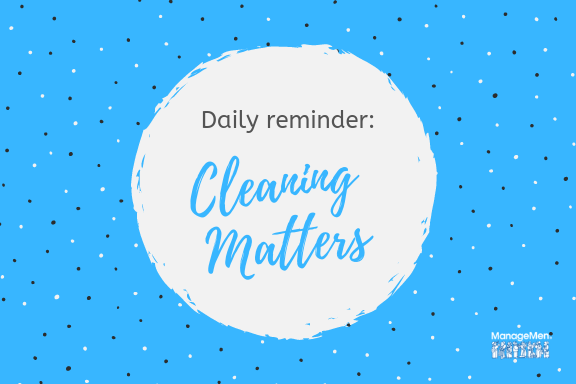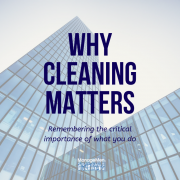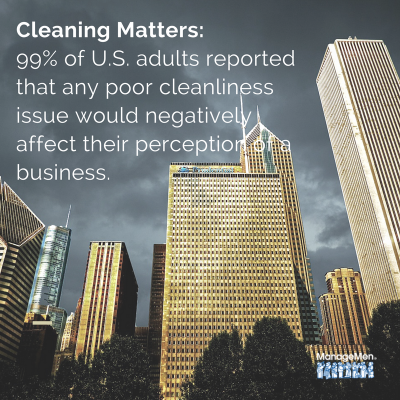Why Cleaning Matters
A little over a year ago, we had a brainstorming session to name our monthly electronic newsletter. As you can imagine, it’s a rollercoaster of fun anytime Ben is at the whiteboard. A series of possible titles made their way to the board, ranging from the basic “ManageMen Minute” to the more audacious “Dirt Diaries.”
In the end, we settled on “Cleaning Matters” because it succinctly sums up our goal of the newsletter—to provide valuable news and information that can be used by cleaning professionals as they work to grow and evolve their cleaning programs. It also illustrates our core ethos—that cleaning MATTERS. How you clean matters. Why you clean matters. When and how often you clean matters. Custodial work MATTERS.
But it’s easy to lose sight of this. It doesn’t matter where or what you clean, this is not an easy business. Between the three C’s (call-offs, complaints and cuts), we see cleaning professionals get waylaid in the day-to-day management issues. We call this “firefighter mode” because professionals are constantly going around and extinguishing issues that come up during the day. One manager recently shared that his job made him feel like a piñata. He felt like he just kept receiving hits before finally busting open (not really, but that’s how he felt).

What do you do to help prevent the daily stresses of custodial work from getting to you? In addition to establishing a regular practice that allows you to decompress, it’s important to remember why we do what we do. Your job is critical, and you can’t communicate its importance to your bosses and staff without realizing and believing it first yourself.
So grab a cup of coffee or a glass of water and sit back to relax for a moment and reflect on why you do what you do. Here are four extremely important reasons why CLEANING MATTERS:
1. Cleaning improves the health of people in the building: Done correctly, cleaning removes unwanted dirt and bacteria from the indoors. Not the keyword “removes”—removing dirt is essential to effectively cleaning for health. Dust, bacteria and mold are just a few of the things that can accumulate indoors without proper cleaning and will have an impact on the health of building occupants.
As Dr. Michael Berry, former EPA administrator, details in his groundbreaking work, Protecting the Built Environment: Cleaning for Health, “….every time carpets and fabrics are emptied of their pollution build-up through professional cleaning methods, there is a health benefit.” And this is only the beginning of how cleaning can impact health.
2. Cleaning helps preserve the built environment (and capital investments). The minute your customer walks in the door, they immediately begin forming a perception of your business based on what they see and experience. Too often, this first-impression is only considered when identifying finishes and furnishings for a business, but not when it comes to how those items will be cleaned and maintained for the longterm. What happens to that beautiful marble floor when someone uses an acid-based cleaner on it?
During the construction or remodel of a building, organizations spend a mind-blowing amount of money on furnishings like carpet, furniture and finishes. Without proper care through regular cleaning and maintenance, the lifespan of these materials will quickly diminish.
3. Cleaning makes us more productive. The popular business magazine Inc. published an article titled “The Incredible Power of a Clean Workspace.” In it, the author argues that unkept and cluttered workplaces create unrecognized stress for workers.
Dutch researchers recently evaluated the correlation between clean office environments and worker productivity in their study: “Impact of cleanliness on the productivity of employees.”
Researchers concluded:
“It is found that a higher objective cleanliness correlates significantly with a higher perceived productivity of employees working in office environments of non-profit organizations in The Netherlands. A higher measured cleanliness also correlates significantly with a higher work satisfaction level of employees working in office environments.”
4. Cleaning makes a difference between lost and repeat customers. As we’ve noted in previous blog posts, people prefer to do business in clean places. QSR Magazine recently highlighted a study that found 93 percent of U.S. adults would not return to a store if they experienced maintenance issues, including odor and dirty restrooms. How the building is cleaned and maintained is a large driver to business success.
We realize your work is hard and often goes unappreciated, but never lose sight of its importance. Thank you.
Click here if you’re not subscribed to our newsletter! Just scroll down and enter your info on the right side of the page and we’ll send you our next issue, which goes out this week!



